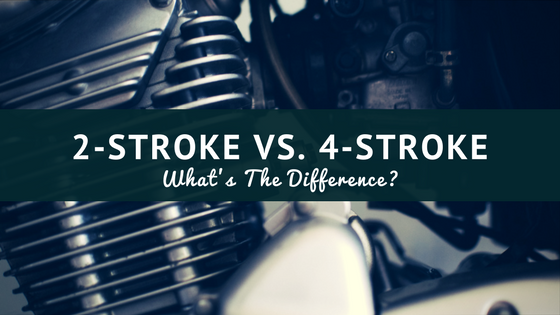Automotive engines have transformed over the years, but two main gasoline powered combustion engine designs remain: the 2-stroke and the 4-stroke. While we’re sure you’ve at least heard these terms before, do you really know the difference between them? How do they work, and which is better? Read on to learn the answers!
How Do Combustion Engines Work, and What Is A “Stroke” Anyways?
In order to understand how these two engines are different, you first need to become familiar with the basics.
During an engine’s combustion cycle, the piston moves up and down within the cylinder. The terms “top dead center” (TDC) and “bottom dead center” (BDC) refer to the piston’s position within the cylinder. TDC is its position nearest to the valves, and BDC is its position furthest from them. A stroke is when the piston moves from TDC to BDC, or vice versa. A combustion revolution or combustion cycle is the complete process of gas and air being sucked into the piston, igniting it, and expelling the exhaust:
- Intake: The piston moves down the cylinder allowing a mixture of furl and air into the combustion chamber
- Compression: The piston moves back up the cylinder; the intake valve is closed to compress the gasses within
- Combustion: A spark from the spark plug ignites the gas
- Exhaust: The piston goes back up the cylinder and the exhaust valve is opened
Difference Between A 2-Stroke & A 4-Stroke
The Difference between a 2-stroke and a 4-stroke engine is how quickly this combustion cycle process occurs, based on the number of times the piston moves up and down during each cycle.
4-Stroke:
In a 4-stroke engine, the piston completes 2-strokes during each revolution: one compression stroke and one exhaust stroke, each being followed by a return stroke. The spark plugs fire only once every other revolution, and power is produced every 4-strokes of the piston. These engines also do not require pre-mixing of fuel and oil, as they have a separate compartment for the oil.
Watch this quick video for a further description of how the 4-stroke engine works:
2-Stroke:
In a 2-stroke engine, the entire combustion cycle is completed with just one piston stroke: a compression stroke followed by the explosion of the compressed fuel. During the return stroke, the exhaust is let out and a fresh fuel mixture enters the cylinder. The spark plugs fire once every single revolution, and power is produced once every 2-strokes of the piston. Two-stroke engines also require the oil to be pre-mixed in with the fuel.
Watch this quick video for a further description of how the 2-stroke engine works:
Pro’s and Con’s:
So, which is ‘better’? Here are a few of the pro’s and con’s to both engine designs:
- As far as efficiency goes, the 4-stroke certainly wins. This is due to the fact that fuel is consumed once every 4 strokes.
- Four-stroke engines are heavier; they weigh upwards of 50% more than a comparable 2stroke engine.
- Typically, a 2-stroke engine creates more torque at a higher RPM, while a 4-stroke engine creates a higher torque at a lower RPM.
- The 4-stroke engine is also much quieter, a 2-stoke engine is significantly louder and has a distinctive, high-pitched “buzzing” sound.
- Because 2-stroke engines are designed to run at a higher RPM, they also tend to wear out faster; a 4-stroke engine is generally more durable. That being said, 2-stroke engines are more powerful.
- Two-stroke engines are a much simpler design, making them easier to fix. They do not have valves, but rather ports. Four-stroke engines have more parts, therefore they are more expensive and repairs cost more.
- Two-stroke engines require pre-mixing of oil and fuel, while the 4-strokes do not.
- Four-strokes are more environmentally friendly; in a 2-stroke engine, burnt oil is also released into the air with the exhaust.
Two-stroke engines are typically found in smaller applications such as remote-controlled cars, lawn tools, chainsaws, boat motors and dirt bikes. Four-stroke engines are found in anything from go-karts, lawnmowers and dirt bikes, right up to the typical internal combustion engine in your vehicle. It’s up to you to decide which engine you prefer, and for what purpose.
At Berryman Products, we are committed to providing prompt personal service and producing products that meet the highest quality standards of performance, reliability and environmental responsibility. Check out our website and Facebook page for accurate information and quality products you need to handle your most common vehicle issues.

